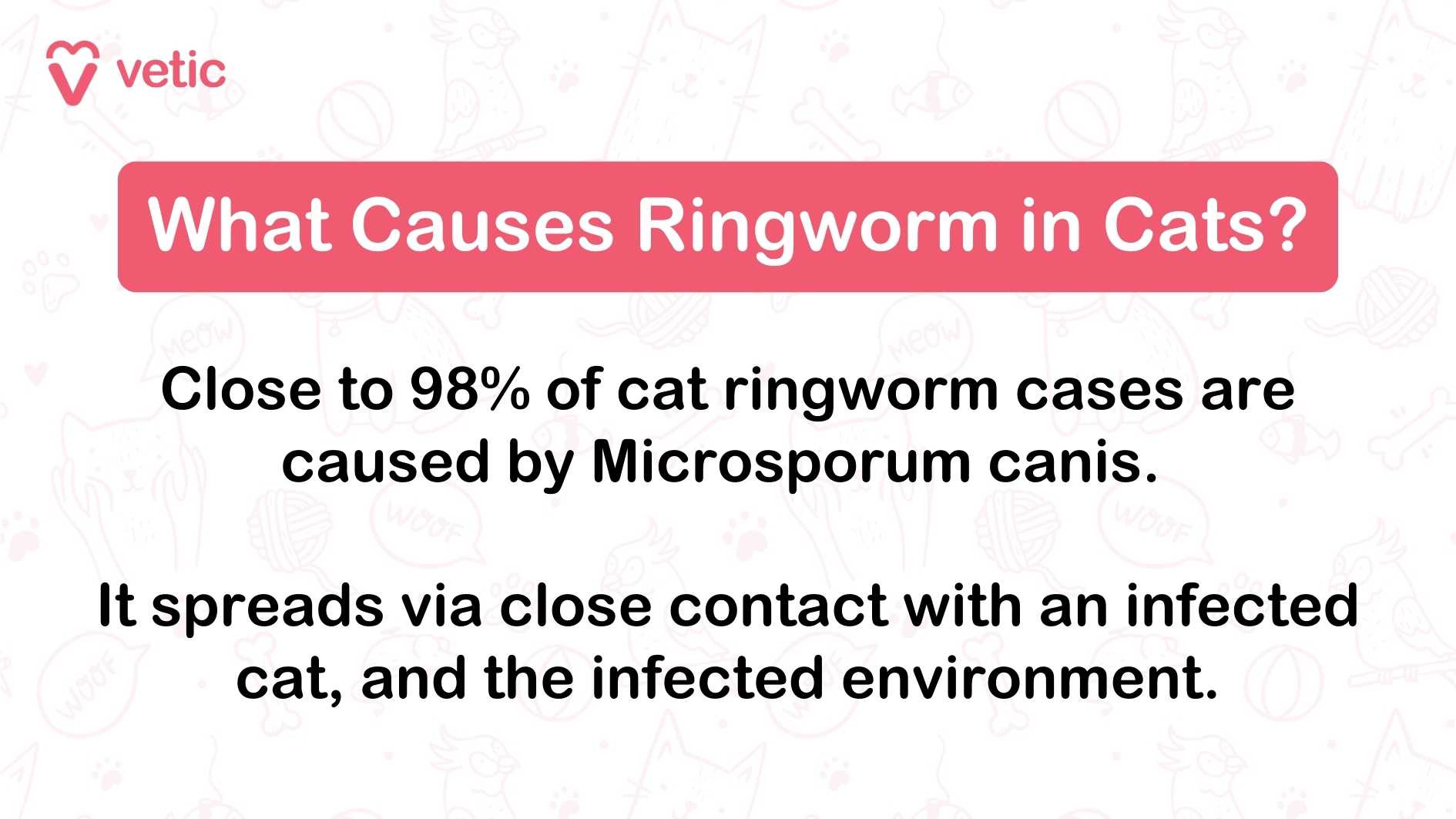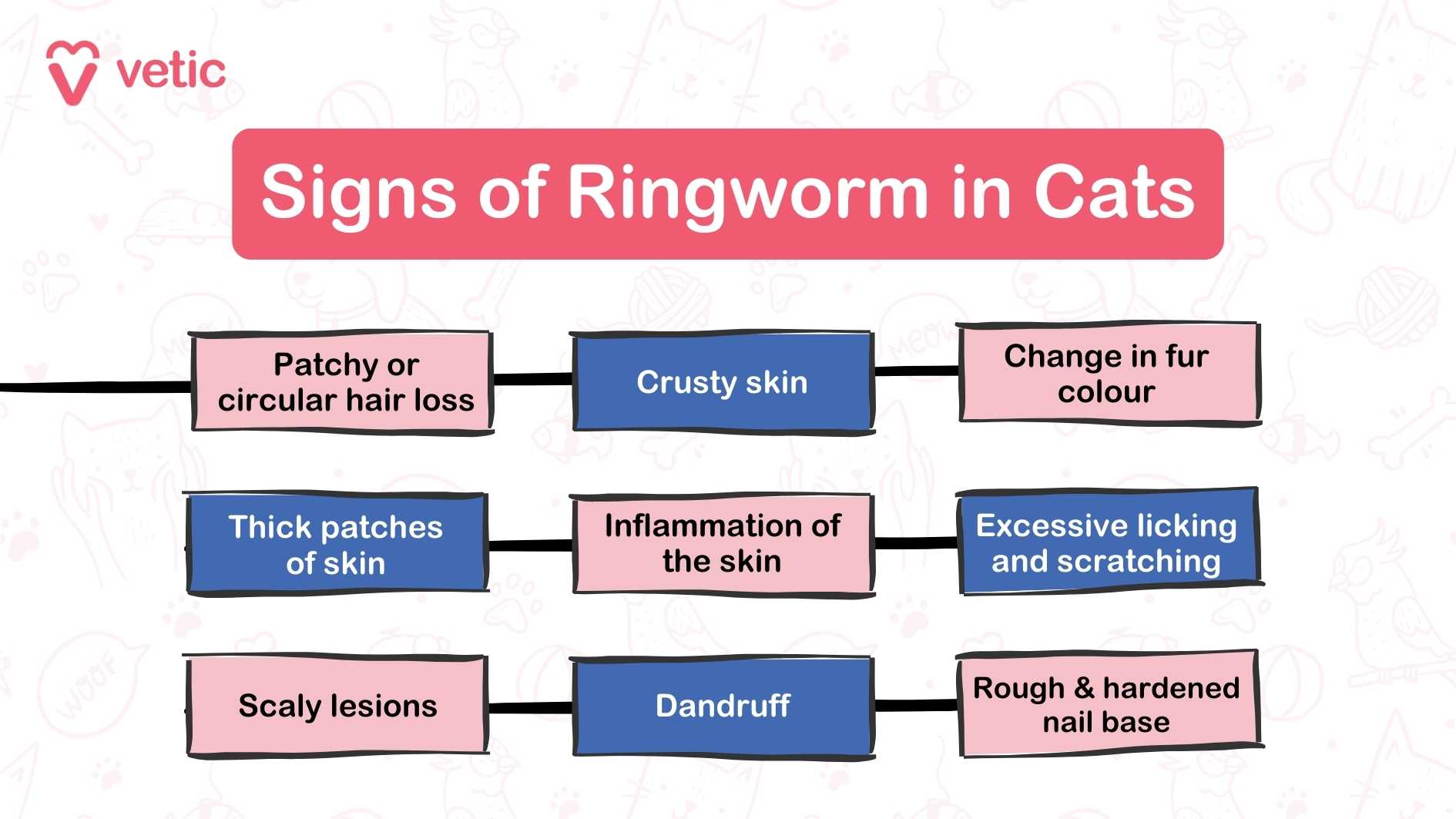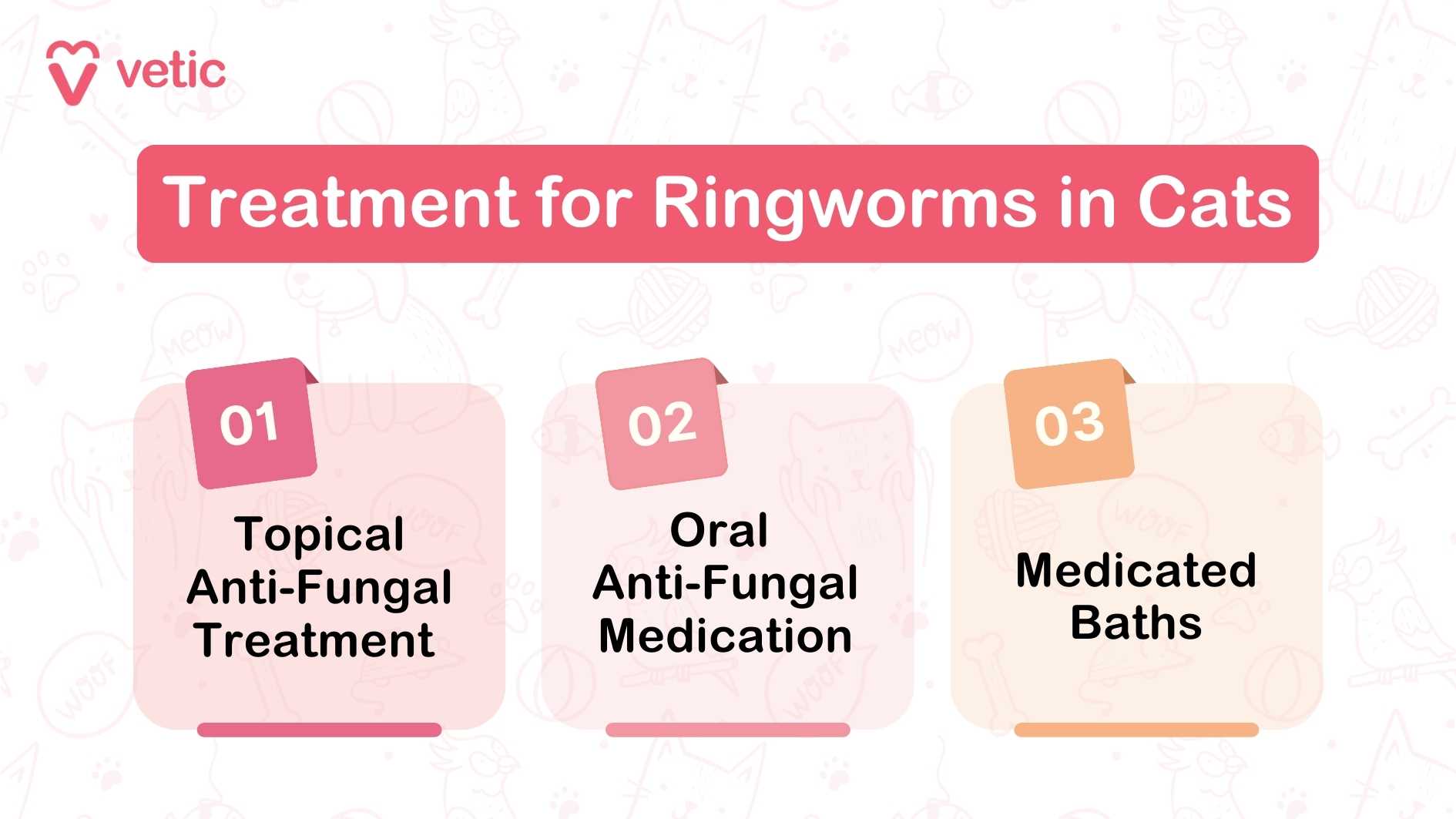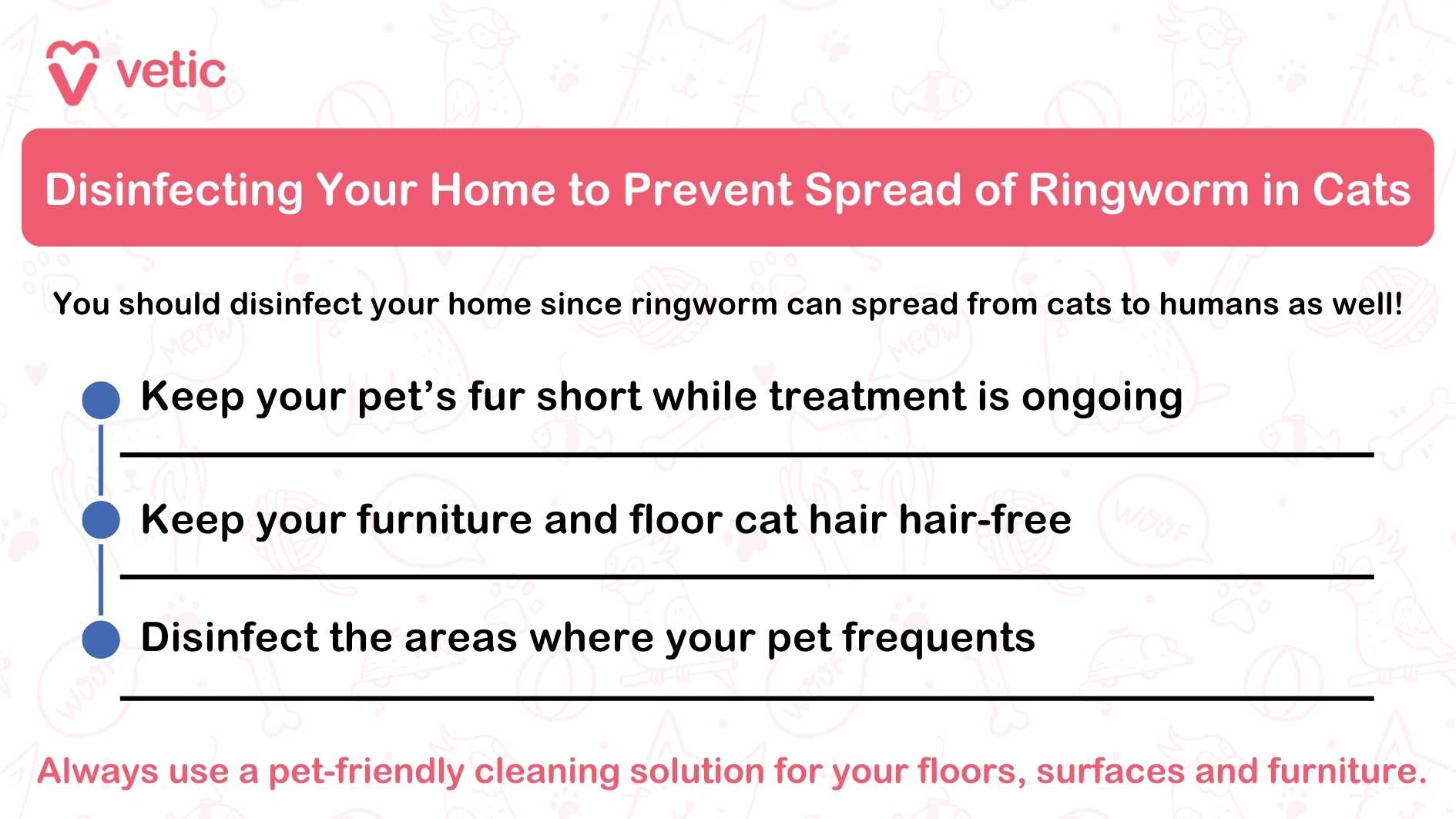Ringworm is not a worm or parasite. Ringworm in cats is the common name for a fungal infection that’s rather familiar in human beings as well. Ringworms can affect your cat’s skin, coat and paws (nails) since it feeds on dead cells.
Ringworm in cats can appear as patchy hair loss and crusty lesions in any part of the body. It can affect the outer ears, neck, and belly regions, along with the nails and paws. It is important to visit the veterinarian since the signs can be similar to the early signs of scabies in cats.
What Causes Ringworm in Cats?
Close to 98% of cat ringworm cases are caused by Microsporum canis.
It spreads via close contact with an infected cat, and also through direct contact with the infected environment. The fungal spores can survive on furniture, clothing and other surfaces for up to 18 months.

Although contact with the ringworm causing organism is very common, not all cats catch the infection. The establishment of ringworm infection also depends upon the skin health of the host, nutritional quality, grooming habits and their natural immunity.
So, kittens and long-haired cats are more susceptible to ringworm infection. Here are the common predisposing factors –
- Age – Kittens and senior cats with low immunity have a high risk of developing ringworm after exposure.
- Climate – Hot and humid climates like that in India are breeding grounds for common fungal infections such as ringworms in cats.
- Environment – Cats living in multi-cat households, shelters and frequenting boardings have higher chances of picking up the fungus from other infected cats.
- Immunity – Cats with FeLV (Feline leukaemia virus) and FIV (feline immunodeficiency virus), or cats on immunosuppressants are at a higher risk of developing fungal infections such as ringworm.
What are the Signs of Ringworm in Cats?

The signs of ringworm in cats is quite evident in infected cats and kittens –
- Patchy or circular hair loss
- Crusty skin
- Change in fur colour
- Thick patches of skin
- Inflammation of the skin
- Excessive licking and scratching
- Scaly lesions (head, back and chest)
- Dandruff
- Rough and hardened nail base
The most severe cases of ringworms in cats observed by our vet showed skin lesions with nodular and raised structures. These are granulomas and they produce discharge frequently.
However, there are multiple cats who do not show any symptoms although they have the infection.
It’s important to note that in both the cases the cats are considered infectious and they are capable of spreading the infection to other cats and humans.
How is Ringworm in Dogs Diagnosed?
Although ringworm is a common skin infection, differential diagnosis is required to ensure correct treatment.
- Veterinarians may rely on physical examination and fluorescent light to look at the fungal infection.
- Microscopy and sample culture are irreplaceable tools when it comes to the detection of fungal infections in pets, such as ringworm in cats.
- Sometimes, more serious cases require skin biopsies or PCR.
Treatment for Ringworms in Cats
The treatment depends upon the extent of the infection, the age of your cat and their overall health. The treatment can be a combination of topical and oral anti-fungal medication for at least a month.

It is important to follow through with the treatment. At the same time, further skin samples and fungal cultures should be conducted during and after the treatment duration to see if the medicines are working.
Topical Treatment (Ointment/Lotion)
These are anti-fungals that come in ointment or lotion form to be applied on the affected areas. This treatment can directly kill the fungal spores which prevents the contamination of the environment.
Oral Medication
Oral anti-fungals are usually prescribed for advanced or severe cases of ringworm in cats. These medications usually stop the reproduction of the fungus and the remaining infection is typically removed using ointments or lotions.
Medicated Baths
In many cases, veterinarians may recommend medicated baths with anti-fungal shampoos to soothe your cat’s skin, reduce the infection, inflammation and itching. If you cannot manage to bathe your cat at home, do opt for professional grooming services who are experienced in dealing with fungal infections in cats.
Like all medicines, anti-fungal therapy for ringworm in cats can also have side effects. Speak to your veterinarian if your cat is showing any signs of discomfort, including diarrhoea, vomiting and loss of appetite. You should not stop the medicines or change their dose without consulting your veterinarian.
Your Cat has Ringworm: How to Disinfect Your Home?

Since ringworm can spread from one cat to another, and even to human beings, it’s important to disinfect the environment.
- Keep your pet’s fur short while treatment is ongoing
- Keep your home clean and hair-free
- Disinfect the areas where your pet sleeps, rests and eats using a pet-friendly kennel cleaner
How Long Will It Take for Ringworms in Cats to Go Away?
Ringworms in cats can be a stubborn infection. You need to keep your home clean while your cat’s ringworm treatment is ongoing.
Even if the redness, scaly skin and scratching goes away, do not stop oral medication or topical application without speaking to your vet first.
Your cat may require medicated baths for quicker recovery. If your veterinarian has recommended them, do take your cat to a reliable veterinary clinic who offer medicated baths for fungal infection in cats.
FAQs on Ringworm in Cats
What is ringworm in cats?
Ringworm is a fungal skin infection in cats, causing red, circular patches with hair loss and scaly skin.
How do cats get ringworm?
Cats contract ringworm through contact with infected animals, contaminated surfaces, or fungal spores in the environment.
What are the symptoms of ringworm in cats?
Common symptoms include red patches, hair loss, itching, and flaky skin, often around the head, ears, and paws.
Is ringworm in cats contagious to humans?
Yes, ringworm can spread from cats to humans through direct contact, so it’s important to handle infected cats carefully.
How is ringworm in cats diagnosed?
Veterinarians use a Wood’s lamp or skin culture to confirm ringworm. Symptoms alone are usually insufficient for diagnosis.
What treatments are available for ringworm in cats?
Ringworm is treated with antifungal medications, topical creams, and sometimes medicated baths. Follow your vet’s treatment plan closely.
How can I prevent ringworm in my cat?
Regular grooming, disinfecting their environment, and limiting exposure to infected animals can help prevent ringworm in cats.
How long does it take for ringworm to clear in cats?
With treatment, ringworm generally clears up in 3 to 6 weeks, but severe cases may take longer.
